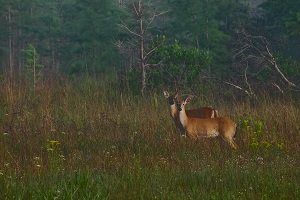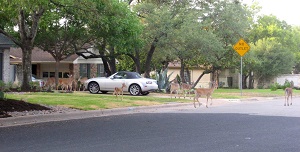
Fall is a busy time for wildlife in the Piedmont, particularly for mammals as they rush to prepare for the coming winter – storing food caches, finding mates, and burrowing den sites. During this time, white-tailed deer enter “the rut”: hormones rage, antlers grow, and males seek out females. Historically, it’s this time of year when you’re most likely to see deer, especially as bucks pursue does and the does play coy. Today, however, you are very likely to encounter deer any time of year — not just during the rut.
It wasn’t always as easy to see deer. In the 1930s, white-tailed deer were virtually extinct in Virginia; to come across a deer was a very remarkable occurrence. Since then, we’ve seen a dramatic turnaround in the population, but this great restoration success has brought with it new challenges.
Our neighbor the White-tailed deer
White-tailed deer are the only deer in eastern North America. They have an enormous range — extending from Canada all the way to Peru. In other words, deer are generalists when it comes their needs. They also have remarkable reproductive potential. A female can have one to three fawns every year starting at 1.5 years. This means a population can double about every one to two years if there is sufficient habitat and low mortality rates!
White-tails are excellent at avoiding being eaten, having evolved with a host of potential predators. Our region used to be home to a number of predators — including wolves, mountain lions, and black bears. Yet, wolves and cougars no longer inhabit east coast today due to humans (any sightings are either dispersed lone individuals from the west or released pets). Today, black bears and coyotes (new to Virginia) are known to occasionally hunt deer, but it’s safe to say a much smaller number of deer are taken down by other animals.
A deer’s real predator in modern times is man. Prior to the creation of state wildlife agencies in the 1900s-1930s, deer were hunted by anyone and at any time of year. This changed with the advent of wildlife management science – which resulted in tightly controlled hunting. White-tails slowly but steadily rebounded from near zero to an estimated 1 million in Virginia today. This is a great success story for conservation, and a similar story has played out for turkey, bear, beavers and other species hunted near extinction.
At the same time that hunting/predation changed, the landscape has changed too. Prior to European arrival, eastern North America was thought to have been a vast, nearly contiguous deciduous forest — not ideal deer habitat. The species does well in mixed habitat, with interspersed woods, fields, and shrubland. In other words, the landscape of the Piedmont today — from the countryside’s fields and forests to suburbia’s lawns — is essentially ideal for deer to thrive. Combine that with decreased hunter access and a regional decline in the number of hunters, and you have a recipe for deer explosion — particularly in suburban landscapes.
Too much of a good thing?

Overabundant deer create a whole host of problems for people and the environment, but here are few of the biggies:
- Traffic collisions: In Virginia you have a 1% chance of hitting a deer any given year. That’s higher than most states and labels us as a “high risk state” by State Farm Insurance.
- Lyme Disease: White-tailed deer do not carry Lyme disease, but they do act as hosts for black-legged ticks (aka: deer ticks) — the carrier of Lyme. More deer means more ticks, which means more Lyme disease.
- Non-Native Invasive Plants: Much of our invasive plant problem is connected to excessive deer. Deer do not like the taste of many invasive plants (e.g. Japanese barberry, Stiltgrass, etc.) — allowing these plants to grow unchecked. Deer also inadvertently spread the seeds of these non-natives plants.
- Native Plants: At the same time, deer really like to eat many of our native plants (they co-evolved with these plants). Rare orchids, the American Chestnut, Oak seedlings, and spring wildflowers are all among their favorite foods. This can lead to the local extinction of plants as deer over-browse them.
- Forest Regeneration: Good, sustainable forestry is near impossible when white-tailed deer populations are high, because native forest regeneration is often inhibited by their browsing.
- Native Wildlife: Excessive deer populations can eliminate habitat for other species. Populations of ground-nesting and low tree-nesting birds — like wood thrushes and American Redstarts — see a decline when deer eat all their natural cover. Deer also gorge on our semi-biennial oak acorn crop, competing with other mammals and birds for this critical food source.
Despite their sometimes annoying and destructive characteristics, I do like deer and believe they have a role in the environment. However, I also like other biodiversity and environmental values. Human activity is the cause of the deer population explosion, so I believe we have an obligation to restore a more balanced ecosystem.
Some believe that nature will sort things out in the long-term. That may eventually occur if/when top predators such as the wolf and mountain lion return. However, we are a long way from having (or allowing) packs of wolves or prowling cougars in the suburbs of Loudoun and Albemarle. Diseases in the deer population may also reduce numbers, and we may already be seeing this with diseases like Chronic Wasting Disease (CWD). Although, this too is not preferred for many reasons.
In the meantime, the environment could use our help, so what’s a person to do?
- Landowner: Take up hunting! Hunting is the single most effective way to manage deer populations. So, if possible, open your lands to hunting. It’s the perfect source of totally carbon-neutral, native meat and a great way to really connect to nature. VA Dept. of Game and Inland Fisheries (DGIF) has a wealth of information on their website — including a model hunting lease. Hunters for the Hungry is a non-profit that gives away meat to local food shelters as a way to help the needed.
- Groups of Landowners: If possible, coordinate hunting with as many neighbors as possible. Deer are smart and their local populations are usually so large that culling from one property isn’t enough to affect their numbers. Landowners can apply also for an out-of season deer permit with DGIF.
- Citizen: Raise awareness with neighbors and public officials. Many people do not recognize that deer populations are so high, and that there are real impacts (it’s easy to overlook the absence of a rare flower or bird that has disappeared due to excessive browse). The more this issues is connected to other issues — like public health and agriculture — the more likely it is that policies and opinions will change. Lastly, encourage land conservation. Suburban development provide great habitat and limits hunting access.
